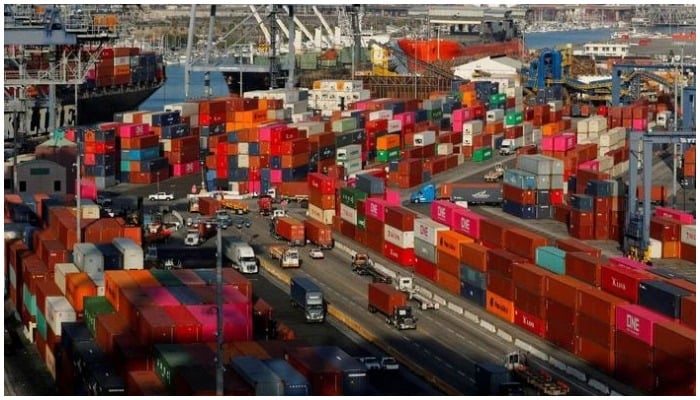Five ways PM Shehbaz Sharif can fix the economy
Before PM Shehbaz embarks on “Misaq-e-Maeeshat”, several decisions are required to restore confidence, trust of local, foreign stakeholders
April 12, 2022

Political instability, during the past few days, gave rise to unprecedented volatility in economic indicators.
During the month of March, consumer prices jumped by 12.2%. On the external side, the current account deficit widened, and central bank reserves as they stand today can barely cover two months of the country’s import payments.
While reserves held by the State Bank of Pakistan (SBP) fell to $11.3 billion by April 1, compared with $16.2 billion a month earlier. This weakened the overall market sentiments and the first week of April witnessed the currency plunging to a record low of Rs188 against the US dollar in the inter-bank market.
On the fiscal side, during the first seven months of the ongoing fiscal year, the budget deficit figures were concerning.
Already, Rs1.9 trillion deficit has been registered. This means borrowing will have to be increased to run government affairs for the remaining part of the fiscal year. No doubt also that the Federal Board of Revenue (FBR) has shown impressive tax collection gains, however, these will not be able to match the pace of expected rise in expenditures. Already, the incoming government announced measures on Monday to expand the government’s administrative, salary, and pensions bill.
For now, the central bank has made the right move.
Foreseeing an overall annual inflation rate of 11% for the ongoing fiscal year, the SBP raised its policy rate by 250 basis points to 12.25%. Among other results, this move will render a slowing down of overall economic growth.
Overall, the GDP growth will also suffer as some cuts in public sector investment are expected to curtail the budget deficit.
Before Prime Minister Shehbaz Sharif embarks on his proposed “Misaq-e-Maeeshat”, several short term decisions are required to restore the confidence and trust of the local and foreign stakeholders, and more importantly stabilise key macroeconomic indicators.
First, the country needs to go back to the fiscal prudence it had promised in the International Monetary Fund (IMF) Article IV Consultation, and the sixth review under the Extended Fund Facility of IMF.
This implies undoing the various populist measures including untargeted subsidies allowed in electricity, gas, and food supplies. Then, the several forms of amnesties in real estate, construction, and allied sectors will have to be done away with.
Second, circular debt has emerged in several sectors due to the government’s intervention. The role of the state in these markets, including the energy markets, should be revisited. And the generation and distribution companies will have to recover the full economic cost from the consumers. There is a case for lifeline consumers paying less, but this can only happen if better targeting mechanisms are in place.
Also, the implementation of a circular debt management plan in the power sector needs to be expedited.
The energy sector state-owned enterprises (SOEs) have a major share in overall losses by government entities, which is why governance reforms at these SOEs should be prioritized. The tariffs in both oil, power, and gas sectors need to represent the true economic cost. This also implies that subsidies in the energy sector should strictly be for lifeline consumers.
The reform of this sector will only gain strong roots if overtime regulators – National Electric Power Regulatory Authority, and Oil and Gas Regulatory Authority are allowed due autonomy. Given the interdependencies, it is important to merge all regulators in the energy space.
One of the ways to protect against the energy price shocks is to simultaneously strengthen energy conservation efforts and overtime alter the energy mix.
Third, there has to be a consensus on what import regime the country requires.
Spurts in economic growth give rise to higher levels of imports in turn resulting in unsustainable trade deficits. All governments are guilty of not putting in place trade taxes and tariffs that support growth and investment in exporting sectors (and encourage new sectors and firms to become exporters of goods and services). Gains in tariff policy are often undone by other inward looking policies which foster anti-export bias.
Fourth, the central bank’s independence should allow for a monetary policy with positive real interest rates, and market determined exchange rates. The government should refrain from resorting to the central bank for borrowing needs.
The SBP will need to ensure the implementation of the regulatory and supervisory measures, including strengthening the Anti-Money Laundering and Counter Financing of Terrorism which in turn will support exit from the FATF grey list.
Continued build-up of forex reserves is also important to support the import needs of a growing economy and protect against global price shocks.
Finally, the new prime minister, and his economic team, must listen carefully to the disgruntled investors including the Chinese.
Delays in addressing concerns related to ongoing projects under the China-Pakistan Economic Corridor (CPEC) and special economic zones have hurt the current and future expected phases of the CPEC.
The previous government had embarked on the Pakistan Regulatory Modernization Initiative (PRMI) with support from all provincial governments – a step which the incoming government should continue on a priority basis. This is expected to significantly cut the red tape, reduce the human interface at regulatory bodies, and reduce the high (regulatory) costs faced by established and startup firms.
Ahmed is an economist and former civil servant. He tweets @vaqarahmed.









